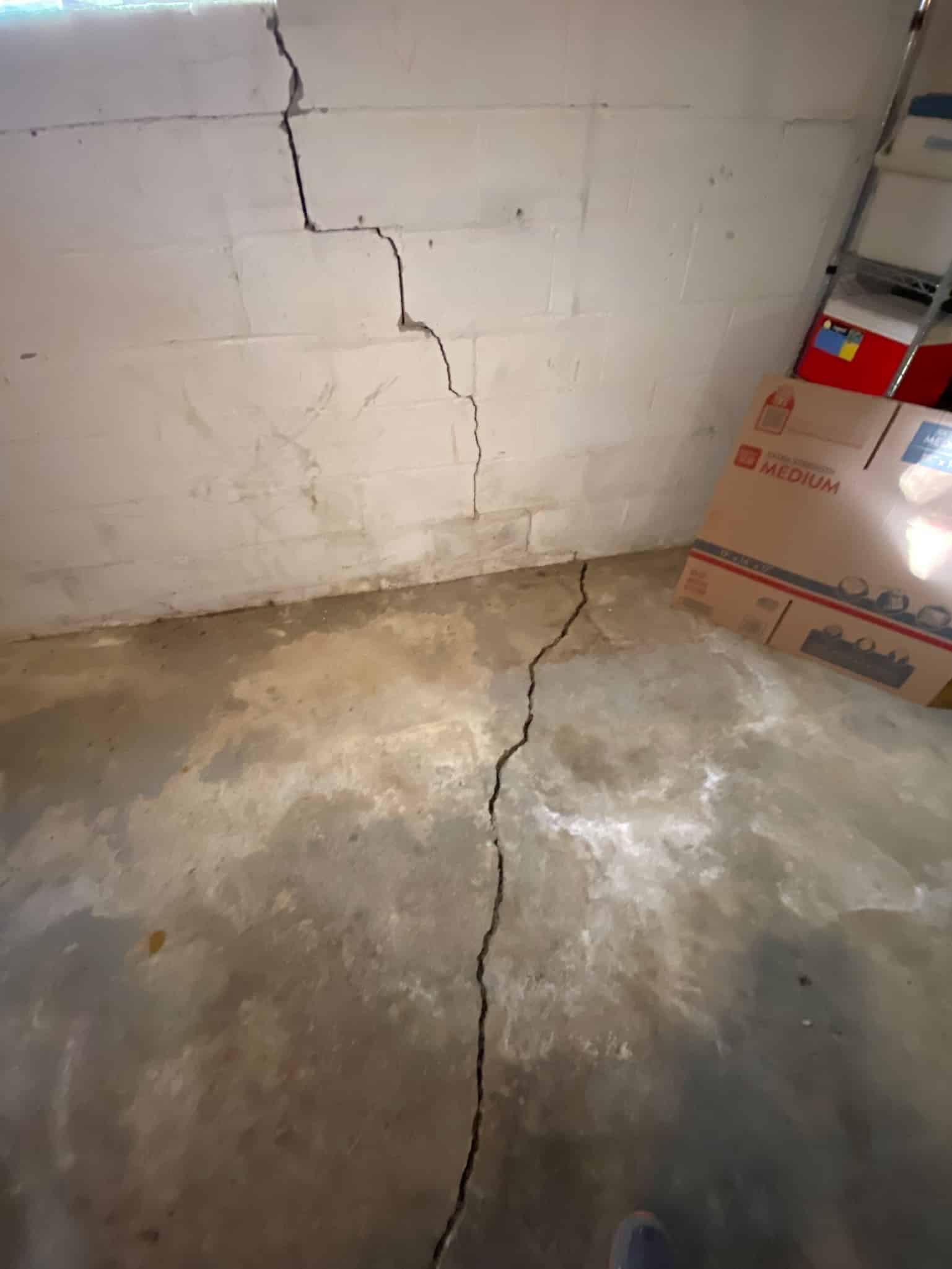
A hairline crack in your basement floor might not seem like much. Maybe it’s a thin line running across the concrete or a small section where the floor seems to have shifted slightly. Many homeowners brush off these imperfections as normal “settling,” but these seemingly minor cracks can actually hold important clues about your home’s overall foundation health.
Basement floor cracks can be more than cosmetic issues. They can signal deeper foundation problems, moisture intrusion, or structural stress — and ignoring them could lead to more severe (and costly) repairs down the road.
In this article, we’ll decode what your basement floor cracks are really telling you, how to identify different types, and what professional solutions can restore your home’s safety and stability.
🔑 Key Takeaways
- Basement floor cracks can indicate foundation settlement, hydrostatic pressure, or slab movement.
- Types of cracks (hairline, wide, heaving, or sinking) reveal different underlying problems.
- Warning signs include moisture seepage, uneven floors, and new wall cracks.
- Solutions range from crack injections to pier systems and improved drainage.
- Early inspection helps prevent serious structural damage and costly repairs.
Why Basement Floors Crack
Basement floors are typically concrete slabs poured after the foundation walls are built. While strong, these slabs aren’t immune to natural stresses and environmental forces.
Common Causes
Soil Settlement
As the soil beneath your basement shifts or compresses, voids can form, causing the concrete slab above to crack or sink.
Hydrostatic Pressure
Water accumulating under or around the foundation exerts upward pressure on the slab, creating cracks and heaving (upward bending).
Shrinkage Cracks
As concrete cures, it naturally shrinks. Small, thin cracks are common shortly after construction and may not indicate structural issues.
Expansive Soils
Soils with high clay content expand when wet and shrink when dry. This movement can stress and crack the slab above.
Poor Drainage
Water pooling near the foundation can saturate the soil beneath the basement, compromising its stability.
Types of Basement Floor Cracks and What They Mean
Understanding the appearance and behavior of floor cracks can reveal a lot about the underlying problem.
Hairline Cracks
- Appearance: Very thin, barely noticeable, often less than 1/16 inch wide.
- Cause: Concrete shrinkage during curing.
- What It Means: Usually cosmetic. However, monitor for widening or moisture intrusion.
Wide or Widening Cracks
- Appearance: Cracks wider than 1/8 inch, sometimes uneven edges.
- Cause: Significant soil settlement or slab movement.
- What It Means: Potential structural concern needing professional evaluation.
Heaving Cracks
- Appearance: Slab sections pushed upward, often creating uneven surfaces.
- Cause: Hydrostatic pressure or frost heave in colder climates.
- What It Means: Suggests severe soil moisture problems requiring drainage and structural solutions.
Sinking or Settling Cracks
- Appearance: Sections of the floor lower than surrounding areas, often with surrounding cracks.
- Cause: Soil compaction or erosion under the slab.
- What It Means: May indicate serious foundation settlement needing stabilization.
Warning Signs Beyond the Crack
A crack alone doesn’t tell the whole story. Accompanying signs can help determine if you’re facing a deeper issue.
| Sign | Possible Cause |
|---|---|
| Moisture seepage or stains | Hydrostatic pressure or poor drainage |
| Musty odors or mold growth | Water entering through cracks |
| Cracks in basement walls | Settlement or shifting affecting entire foundation |
| Doors and windows sticking | Uneven settling affecting structural alignment |
| Gaps between floor and walls | Foundation movement pulling structural elements apart |
If you notice one or more of these, it’s time for a thorough professional inspection.
Risks of Ignoring Basement Floor Cracks
While small cracks might seem harmless, neglecting them can lead to serious consequences.
Structural Damage
Cracks can signal ongoing soil movement or foundation settlement that, left untreated, can cause walls to bow, shift, or crack.
Water Intrusion
Cracks serve as direct pathways for groundwater, leading to basement flooding, mold, and damage to stored items or finished living spaces.
Mold and Mildew
Moisture from cracks creates ideal conditions for mold, which compromises indoor air quality and poses health risks.
Higher Repair Costs
Early intervention typically involves simpler, less expensive repairs. Delaying action can escalate costs significantly as damage worsens.
Professional Solutions for Basement Floor Cracks
Epoxy or Polyurethane Crack Injections
- Use: Seals cracks to prevent water intrusion and restores structural integrity.
- Best For: Hairline to moderate-width cracks without severe slab movement.
Slabjacking (Mudjacking)
- Use: Lifts and stabilizes sunken basement slabs by injecting a cement-based slurry or polyurethane foam beneath the slab.
- Best For: Sinking or uneven floors due to voids beneath the slab.
Helical or Push Piers
- Use: Stabilizes the entire foundation when cracks result from deeper settlement.
- Best For: Severe settlement affecting both walls and basement floor.
Drainage Improvements
- Use: Reduces hydrostatic pressure and future cracking risks.
- Solutions Include: French drains, exterior waterproofing, sump pump systems.
Floor Replacement (As a Last Resort)
When cracks are too severe or widespread, replacing sections of the floor slab may be necessary. This is often combined with soil stabilization and drainage correction to prevent recurrence.
Real-Life Example: Cracks Uncover Hidden Settlement
A homeowner in Roanoke, VA, noticed several hairline cracks forming across their basement floor. Initially dismissed as normal shrinkage, the cracks widened over a few years. Eventually, parts of the floor became uneven, and water seeped in after heavy rains.
A Seal-Tite inspection revealed differential settlement due to poor drainage and expansive clay soils beneath the home. The repair plan included:
- Installing push piers to stabilize and lift the foundation.
- Performing slabjacking to correct uneven basement floors.
- Adding an interior drainage system and sump pump to manage groundwater.
The proactive repairs not only stopped the cracks from worsening but also protected the home from future structural damage and water intrusion.
FAQs: Basement Floor Cracks
Are all basement floor cracks serious?
No. Hairline cracks from normal curing are common. However, cracks that widen, allow water in, or are accompanied by other structural issues should always be professionally assessed.
Can I seal cracks myself?
Small, stable cracks can be sealed with DIY kits, but if you’re unsure of the cause or if cracks are widening, professional evaluation is strongly recommended.
Will sealing the crack stop my basement from leaking?
Sealing may temporarily reduce leaks, but if underlying drainage or soil problems persist, new cracks or leaks may appear elsewhere.
Can cracks affect my home’s resale value?
Yes. Visible foundation cracks can lower property value and deter potential buyers. Professional repairs and documentation can help maintain value.
How much does it cost to repair basement floor cracks?
Costs vary widely. Simple crack sealing may be a few hundred dollars, while slabjacking or pier systems can range from $3,000 to $15,000+ depending on severity.
Conclusion: Listen to What Your Floor is Telling You
Your basement floor does more than support storage shelves or your workout equipment — it can serve as an early warning system for deeper foundation issues. By paying attention to cracks and understanding what they mean, you can protect your home before minor concerns turn into major repairs.
Whether it’s a thin hairline mark or a widening gap with moisture, don’t guess or ignore it. Contact Seal-Tite Basement Waterproofing for a professional foundation assessment. Our team will help you understand the cause of the cracks, design a customized repair plan, and restore your peace of mind.
When it comes to your foundation, every crack tells a story — make sure you’re listening.

Seal-tite Basement Waterproofing Co. is a full service basement environment contractor. We carry an A+ Better Business Bureau rating. We repaired over 40,000 homes and structures in Virginia, West Virginia, Tennessee, and North Carolina. We are fully insured and licensed. We have worked in all types of locations, including residential and commercial locations, government agencies, colleges, hospitals, churches, and condo associations.
Seal-tite® offers a lifetime transferable warranty. We carry a Class A Contractor’s License and we are fully insured. Our satisfied customers range from government agencies to businesses, hospitals, colleges, churches, and thousands of homeowners. Your home is probably the single largest investment you will make in your lifetime. Don’t wait, call Seal-tite® to help make your home dry, safe and livable.

